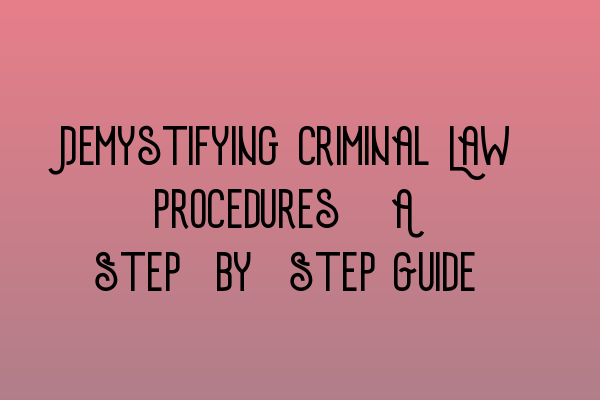Demystifying Criminal Law Procedures: A Step-by-Step Guide
At SQE Criminal Law & Practice Law UK, we understand that the criminal law procedures can be complex and daunting. That’s why we’ve created this step-by-step guide to help demystify the process and provide clarity to those involved in criminal cases.
Step 1: Arrest and Detention
The arrest is the first step in the criminal law process. It occurs when a person is taken into custody by the police on suspicion of committing a crime. During the arrest, the individual’s rights must be read to them, including the right to remain silent and the right to legal representation. If detained, the person may be held for a certain period, depending on the nature of the offense.
Step 2: Investigation and Gathering Evidence
After the arrest, the police will conduct an investigation to gather evidence against the individual. This involves collecting witness statements, examining physical evidence, and interviewing potential witnesses. The evidence gathered plays a crucial role in determining the strength of the case.
Step 3: Charging
If the investigating officers believe that there is enough evidence to support a criminal charge, the charging phase begins. The charges are formally brought against the accused, outlining the specific criminal offense they are alleged to have committed. This marks the official start of the legal proceedings.
Step 4: Bail Hearing
Depending on the seriousness of the offense and the individual’s criminal history, a bail hearing may be required. During the hearing, the court determines whether the accused can be released on bail until the trial date or if they should be held in custody. Factors such as flight risk and threat to public safety are considered in this decision-making process.
Step 5: Pre-Trial Proceedings
Before the trial, there are various pre-trial proceedings that take place. These may include plea negotiations, disclosure of evidence between the prosecution and defense, and preliminary hearings to address any legal issues or challenges that may arise.
Step 6: Trial
The trial is where the prosecution presents their evidence and arguments to prove the defendant’s guilt beyond a reasonable doubt. The defense has the opportunity to challenge the evidence, cross-examine witnesses, and present their own case. The judge or jury then reaches a verdict based on the evidence presented.
Step 7: Sentencing
If the defendant is found guilty, the sentencing phase follows. The judge considers various factors, such as the severity of the offense, the defendant’s criminal history, and any mitigating circumstances, to determine an appropriate punishment.
Conclusion
Understanding the step-by-step process of criminal law procedures is essential when navigating the legal system. By following this guide, you can familiarize yourself with the process and make informed decisions regarding your legal rights and options.
If you want to learn more about legal processes and regulations in the UK, check out our related articles:
- Demystifying the Solicitors Qualifying Examination Format
- LLC Formation Made Simple: Step-by-Step Guide for UK Entrepreneurs
- LLC Formation: A Step-by-Step Guide for UK Entrepreneurs
- Business Regulations in the UK: A Comprehensive Overview
- Ethical Considerations in UK Law: Upholding Professional Standards
